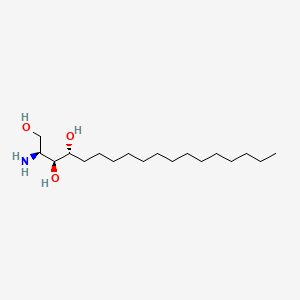| Authors | Title | Published | Journal | PubMed Link |
|---|---|---|---|---|
| Barreto-Bergter E et al. | Structural analysis of fungal cerebrosides. | 2011 | Front Microbiol | pmid:22164155 |
| Veerapen N et al. | Synthesis of truncated analogues of the iNKT cell agonist, α-galactosyl ceramide (KRN7000), and their biological evaluation. | 2011 | Bioorg. Med. Chem. | pmid:21145749 |
| Nimrichter L and Rodrigues ML | Fungal glucosylceramides: from structural components to biologically active targets of new antimicrobials. | 2011 | Front Microbiol | pmid:22025918 |
| Martinková M et al. | A facile synthesis of D-ribo-C(20)-phytosphingosine and its C2 epimer from D-ribose. | 2011 | Carbohydr. Res. | pmid:21703597 |
| Fu C et al. | Metabonomics study of the protective effects of green tea polyphenols on aging rats induced by d-galactose. | 2011 | J Pharm Biomed Anal | pmid:21444175 |
| Van Zeebroeck G et al. | A split-ubiquitin two-hybrid screen for proteins physically interacting with the yeast amino acid transceptor Gap1 and ammonium transceptor Mep2. | 2011 | PLoS ONE | pmid:21912684 |
| Uchida Y | The role of fatty acid elongation in epidermal structure and function. | 2011 | Dermatoendocrinol | pmid:21695014 |
| Ideta R et al. | Orally administered glucosylceramide improves the skin barrier function by upregulating genes associated with the tight junction and cornified envelope formation. | 2011 | Biosci. Biotechnol. Biochem. | pmid:21821935 |
| Lee WS | Integral hair lipid in human hair follicle. | 2011 | J. Dermatol. Sci. | pmid:21906914 |
| Coddens A et al. | Erythrocyte and porcine intestinal glycosphingolipids recognized by F4 fimbriae of enterotoxigenic Escherichia coli. | 2011 | PLoS ONE | pmid:21949679 |
| Merrill AH | Sphingolipid and glycosphingolipid metabolic pathways in the era of sphingolipidomics. | 2011 | Chem. Rev. | pmid:21942574 |
| Koeller CM and Heise N | The Sphingolipid Biosynthetic Pathway Is a Potential Target for Chemotherapy against Chagas Disease. | 2011 | Enzyme Res | pmid:21603271 |
| Murakami I et al. | Phytoceramide and sphingoid bases derived from brewer's yeast Saccharomyces pastorianus activate peroxisome proliferator-activated receptors. | 2011 | Lipids Health Dis | pmid:21861924 |
| Rives A et al. | Asymmetric synthesis and cytotoxic activity of isomeric phytosphingosine derivatives. | 2011 | Org. Biomol. Chem. | pmid:21986639 |
| Cheng JM et al. | An improved synthesis of dansylated α-galactosylceramide and its use as a fluorescent probe for the monitoring of glycolipid uptake by cells. | 2011 | Carbohydr. Res. | pmid:21463856 |
| Hasegawa T et al. | Dietary glucosylceramide enhances cornified envelope formation via transglutaminase expression and involucrin production. | 2011 | Lipids | pmid:21416143 |
| Becker S et al. | Follicular fluid high-density lipoprotein-associated sphingosine 1-phosphate (S1P) promotes human granulosa lutein cell migration via S1P receptor type 3 and small G-protein RAC1. | 2011 | Biol. Reprod. | pmid:20980685 |
| Loewith R and Hall MN | Target of rapamycin (TOR) in nutrient signaling and growth control. | 2011 | Genetics | pmid:22174183 |
| Jung JC et al. | Phytoceramide shows neuroprotection and ameliorates scopolamine-induced memory impairment. | 2011 | Molecules | pmid:22037667 |
| Liu Z et al. | Total synthesis of α-1C-galactosylceramide, an immunostimulatory C-glycosphingolipid, and confirmation of the stereochemistry in the first-generation synthesis. | 2011 | J. Org. Chem. | pmid:21958232 |
phytosphingosine
phytosphingosine is a lipid of Sphingolipids (SP) class. Phytosphingosine is associated with abnormalities such as Infection, Nodule, Dehydration, Neuropathy and nervous system disorder. The involved functions are known as Saturated, sphingomyelin synthase activity, Heat-Shock Response, Cell Growth and Apoptosis. Phytosphingosine often locates in Clone, Protoplasm, Mitochondria, soluble and Cytoplasmic matrix. The associated genes with phytosphingosine are SGMS1 gene, BCL2 gene, Chromatin, Homologous Gene and DLEU2 gene. The related lipids are Sphingolipids, inositolphosphorylceramide, Phosphatidylserines, dihydroceramide and Fatty Acids. The related experimental models are Knock-out.
Cross Reference
Introduction
To understand associated biological information of phytosphingosine, we collected biological information of abnormalities, associated pathways, cellular/molecular locations, biological functions, related genes/proteins, lipids and common seen animal/experimental models with organized paragraphs from literatures.
What diseases are associated with phytosphingosine?
phytosphingosine is suspected in Infection, Nodule, Dehydration, Neuropathy, nervous system disorder, Atopic and other diseases in descending order of the highest number of associated sentences.
Related references are mostly published in these journals:
| Disease | Cross reference | Weighted score | Related literature |
|---|
No disease MeSH terms mapped to the current reference collection.
PubChem Associated disorders and diseases
What pathways are associated with phytosphingosine
There are no associated biomedical information in the current reference collection.
PubChem Biomolecular Interactions and Pathways
Link to PubChem Biomolecular Interactions and PathwaysWhat cellular locations are associated with phytosphingosine?
Visualization in cellular structure
Associated locations are in red color. Not associated locations are in black.
Related references are published most in these journals:
| Location | Cross reference | Weighted score | Related literatures |
|---|
What functions are associated with phytosphingosine?
Related references are published most in these journals:
| Function | Cross reference | Weighted score | Related literatures |
|---|
What lipids are associated with phytosphingosine?
Related references are published most in these journals:
| Lipid concept | Cross reference | Weighted score | Related literatures |
|---|
What genes are associated with phytosphingosine?
Related references are published most in these journals:
| Gene | Cross reference | Weighted score | Related literatures |
|---|
What common seen animal models are associated with phytosphingosine?
Knock-out
Knock-out are used in the study 'Role for de novo sphingoid base biosynthesis in the heat-induced transient cell cycle arrest of Saccharomyces cerevisiae.' (Jenkins GM and Hannun YA, 2001) and Knock-out are used in the study 'SVF1 regulates cell survival by affecting sphingolipid metabolism in Saccharomyces cerevisiae.' (Brace JL et al., 2007).
Related references are published most in these journals:
| Model | Cross reference | Weighted score | Related literatures |
|---|
